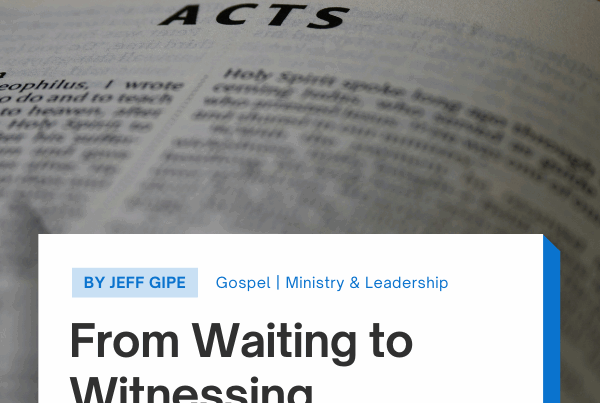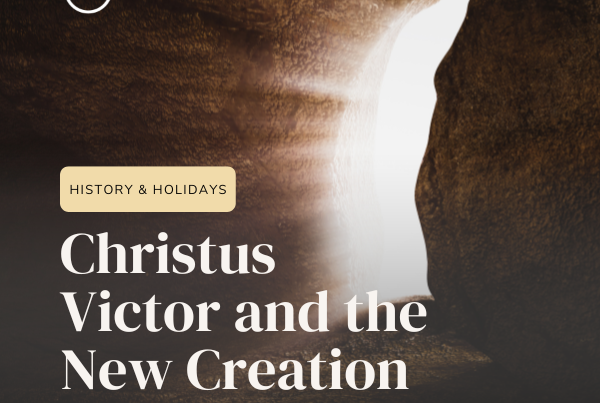
Part 3 of 3
* This article is adapted from a series of papers written for Western Seminary.
To recap the previous articles in this series, while acknowledging that the primary focus of the incarnation is upon the Son of God putting on flesh, being born in Bethlehem, and being given the name foretold by the angel Gabriel as Yeshua, the rescuer of Israel, this three-part Advent series seeks to also acknowledge that this act of Jesus’ incarnation is a harmonious activity with implementations involving all three Persons of the Godhead.
My intention is to present the Advent by focusing on the Holy Spirit’s activity in the nativity story. It is important to recognize that the Holy Spirit is present in the incarnation, ministry, and resurrection of the Son. In each implement of the Father’s plan of redemption, it is the Spirit that empowers and reveals what the Son is accomplishing. It is through the eternal Spirit that Christ offered Himself without blemish to God (Heb. 9:14 CSB). Therefore, it is fitting to see how the Spirit operates also in the complete nativity story. My goal is to do just that by focusing on the Spirit’s activity in terms of prophetic pronouncement, conception, announcement and reception, and finally, illumination.
Prophetic Pronouncement
The Holy Spirit’s involvement in the incarnation was not one of unique character to Himself nor was it an act that went against His characteristics. The Holy Spirit’s first revelatory illumination to us concerning Himself is His participation with Father and Son in the creation of all things. The same Spirit that hovered over the chaotic waters during creation’s coming into existence through the Word of God is the same Spirit that gives life to flesh and anoints the Son of God in the flesh for His particular office as Messiah. As Christopher J.H. Wright explains, “He is the Spirit who anointed the kings, and ultimately anointed Christ the Servant-King. And he is the Spirit through whom the whole creation will finally be renewed in, through and for Christ.”[1] Therefore this act of prophetic pronouncement of what He will do in the conception of Jesus in Mary’s womb throughout the centuries through the prophets is consistent with His creative and life-sustaining character. Isaiah 61:1 is an example of this consistency. The Spirit of YHWH is upon Isaiah and has anointed him to prophetically declare the Gospel coming. The broken will be healed, the captives will be liberated, and the prisoners will receive their freedom.
This consistency of the Spirit’s character to not only pronounce this but to fulfill it through the Messiah Jesus is a powerful one. Therefore, it is simple consistency that Jesus returns from His temptation in the wilderness full of the power of the Spirit to then preach the prophecy of Isaiah’s words in Isaiah 61, as fulfilled in His Personhood. Jesus taught us that one of the primary characteristics of the Spirit is that He comes to convict the world about sin and righteousness. Sin and righteousness are in a way the example of humanity, sin representative of the first Adam, and righteousness representative of the second Adam: Jesus Christ. The Holy Spirit knows perfectly both sides. Christ and His righteousness being the answer to our loss in sin.
The prophets understood this as well. During the time of the prophet Micah, false prophets were proclaiming an ease of sin and a false righteousness. The answer from Micah was the filling of the Spirit to bring cleansing truth: “As for me, however, I am filled with power by the Spirit of the LORD, with justice and courage, to proclaim to Jacob his rebellion and to Israel his sin.” (Mic. 3:8). However, the prophetic word finalizes in the promise of compassion and that one day the iniquities of the nations will be vanquished and all of our sins will be cast into the depths of the sea. Who will do this? The incarnate Son of God.
Conception
The life-giving Spirit is given the privilege of harmoniously and supernaturally conceiving Jesus in the womb of Mary. There are two facets understood in Scripture that occur that are not mutually exclusive but are both expressions of the Trinity. First, the Holy Spirit will come upon you. Second, the Most High will overshadow you. There is mystery in the execution of this act that Scripture simply does not reveal. However, the term “overshadow” has connection to the presence of God over the Tabernacle and the Temple. I. Howard Marshall, in the New Bible Commentary, explains “The description is reminiscent of the glory of God coming to rest upon the Tabernacle (Ex. 40:35). Overshadow is not a euphemism for ‘beget’: the language does not indicate any kind of sexual intercourse between God and Mary.”[2]Once this occurs, it seems as if the Holy Spirit is directly connected to the narrative of Jesus all the way to Pentecost with the continuation of His ministry.
Matthew records it this way: “What has been conceived in her is from the Holy Spirit.” (Matt. 1:20). Frederick Dale Bruner reflects that this work involves two major acts, stating, “The Spirit brings Christ down to earth and makes Him human (as here and in 1 John 4); second, the Spirit lifts Christ up and shows Jesus’ divinity. In other words, the Holy Spirit is a good theologian and gives two main courses: The True Humanity of Jesus Christ the first semester, and the The True Divinity of Jesus Christ the second. It is the work of the Holy Spirit, in either course, to bring Jesus Christ into human lives. ‘Into’ is the key preposition for the work of the Spirit.”[3]
Announcing and Receiving
The next occurrence of the Holy Spirit in the incarnation story is the presence of the Spirit in announcing the coming birth of the Messiah through the leaping of John the Baptist in his mother’s (Elizabeth’s) womb. According to Luke 1:41, Elizabeth hears the voice of Mary, and immediately the Holy Spirit fills her. Through that filling, Elizabeth receives the word of knowledge through the Spirit that Mary is carrying the Messiah. As evidence of the Spirit’s presence, John the Baptist leaps for joy in his mother’s womb. From here it seems Mary is moved to worship the Lord in prophetic song, a song reminiscent of Hannah’s song in 1 Samuel 2. The song is not quiet or reflective but is again representative of the Spirit’s consistent message of redemption from sin and judgement against the proud, mighty, and the rich. This consistent message of judgment over sin and eventual righteousness imparted upon the forgiven has a dominating quality.
This revelatory announcement from the Spirit continues through Jesus’ birth into His circumcision rite in encountering the elder Simeon. This elder has the marks of a prophet and is described not only as righteous and devout, but specifically: “… and the Holy Spirit was on him.” (Luke 2:16). The Holy Spirit is mentioned three times in the narrative concerning Simeon’s life and activity: The Holy Spirit was upon him, The Holy Spirit gave him a promise concerning his witness of the Messiah, and he was guided by the Spirit into the Temple. Even this case presents a rarity concerning a simple, faithful elder living in Jerusalem, and not a high religious leader of the day. Again, consistent with the Holy Spirit’s message since the fall of man, Simeon’s spirit-filled song announces that this boy’s act of redemption will not only affect Israel, but all of the world, fulfilling the Abrahamic covenant of all nations being blessed: “A light for the revelation to the Gentiles and glory to your people Israel.” (Luke 2:32).
Illumination
Finally, the beauty of Jesus’ incarnation through the Spirit is that we are finally given the privilege of illuminative witness to the Trinity themselves. Paul’s letter to the Ephesians beautifully accounts that this work of adoption for all who believe has always been a harmonious activity of the Trinity together. The Father has chosen us, the Son has purchased us, and the Spirit has sealed us by the gospel of salvation, in which we have believed. Paul writes, “The Holy Spirit is the down payment of our inheritance, until the redemption of the possession, to the praise of his glory.” (Eph. 1:1-14).
Malcolm B. Yarnell explains it in this way, “God the Father is the originating subject of the blessing; the Lord Jesus Christ is the active eternal agent that brings the blessing into history through the incarnation and the cross; and the Holy Spirit is the blessing made continually present to humanity. Where the metaphysical hymn of Ephesians 1 demonstrates the descent of divine grace, Ephesians 2:18 demonstrates the ascent of humanity to God … Incorporated with Christ and indwelt by the Holy Spirit, the new humanity is brought before the Father. ‘For through him [Jesus Christ; v. 13] we both have access in one Spirit to the Father’. Ephesians 1:3–14 evinces both the descent of blessing from God and the ascent in glory to God.”[4]
Holistically Presenting the Incarnation and Nativity Story
In conclusion, if the three Persons of the Trinity are harmoniously involved in the creation, redemption, and consummation of all things, then we are charged as shepherds and teachers to holistically present the incarnation and the Christmas story as a harmonious Trinitarian act as well. We have access to the blessing of illumination as we invest in a more trinitarian perspective as we preach. Consequently, a broader trinitarian perspective leads us to preach even more. Specifically, when we focus on the activity of the Spirit, and we make obedient action concerning a deeper submission to His present active work in our lives, we find we preach Christ more authentically, because the Spirit proclaims the ultimate work of Jesus as being one that brings glory to the Father. Ultimately, it is the Spirit that bears witness of Jesus as John the Gospel writer attests, and He will take what is Christ’s and declare it to us. We simply need to have our ears open to hear and be illuminated (Jn. 16:14).
___________________________________________________________________________________________________
References
[1] Christopher J.H. Wright, Knowing God Through the Old Testament (Downers Grove: InterVarsity Press, 2014 ), Kindle Edition, 412.
[2] I. Howard Marshall, “Luke” in New Bible Commentary: 21st Century Edition, 4th ed., ed. D. A. Carson et al. (Downers Grove: InterVarsity Press, 1994), 982.
[3] Frederick Dale Bruner, Matthew: A Commentary Volume 1: The Christbook Matthew 1-12 (Grand Rapids: Eerdmans Publishing, 2007), 27.
[4] Malcolm B. Yarnell, God the Trinity: Biblical Portraits (Nashville: B&H Publishing Group, 2016 ), Kindle Edition.










